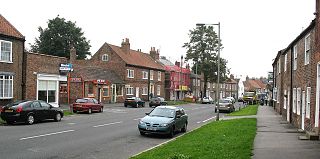
Fulford is a historic village and civil parish on the outskirts of York, in the York district, in the ceremonial county of North Yorkshire, England. Fulford is located 2 miles (3 km) to the south of the city, on the east bank of the River Ouse.
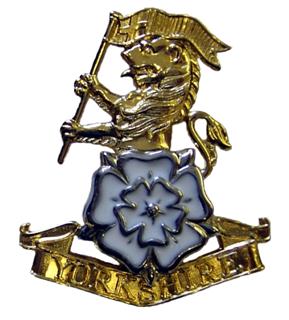
The Royal Yorkshire Regiment is an infantry regiment of the British Army, created by the amalgamation of three historic regiments in 2006. It lost one battalion as part of the Army 2020 defence review. The regiment's recruitment area covers the ceremonial counties of the East Riding of Yorkshire, North Yorkshire, South Yorkshire and West Yorkshire; areas near Barnsley are recruitment area for the Rifles.
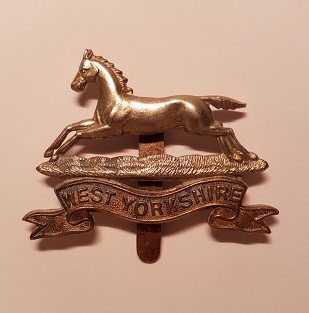
The West Yorkshire Regiment (Prince of Wales's Own) (14th Foot) was an infantry regiment of the British Army. In 1958 it amalgamated with the East Yorkshire Regiment (15th Foot) to form the Prince of Wales's Own Regiment of Yorkshire which was, on 6 June 2006, amalgamated with the Green Howards and the Duke of Wellington's Regiment (West Riding) to form the Yorkshire Regiment (14th/15th, 19th and 33rd/76th Foot).

The 15th Infantry Brigade, later 15 Brigade, was an infantry brigade of the British Army. It was part of the regular 5th Infantry Division during the First World War and Second World War, and was subsequently part of the 2nd Infantry Division in the north of the United Kingdom, with specific responsibility for the areas of North East England and Yorkshire and the Humber.
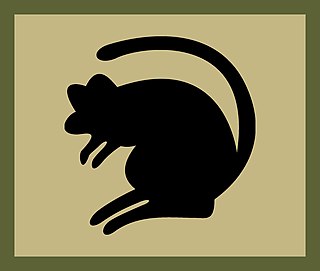
4th Light Brigade Combat Team, previously known as 4th Infantry Brigade and Headquarters North East, and before that as 4th Mechanized Brigade and before that 4th Armoured Brigade is a brigade formation of the British Army, currently based in Catterick, North Yorkshire as part of 1st Division. The brigade, now known as the 'Black Rats', was formed in 1939 and fought in the Second World War in the Western Desert Campaign in North Africa. The Black Rats were subsequently involved in the invasion of Sicily and fighting in Italy before taking part in the Battle of Normandy and the advance through Belgium, Holland and into Germany.

The 11th Security Force Assistance Brigade is a brigade of the British Army which is intended to train and assist foreign forces. In 2021, under the Future Army changes, the brigade was redesignated, formerly being the 11th Infantry Brigade & HQ South East. Prior to the Army 2020 changes in 2013, the brigade was temporarily activated for deployment to Afghanistan. Originally formed in the Second Boer War, the brigade was and engaged during both World Wars.
The 19th Brigade is an Army Reserve brigade of the British Army. As the 19th Infantry Brigade it fought in the First and Second world wars.

Copthorne Barracks was a British Army military installation in Copthorne, a suburb of Shrewsbury in Shropshire, England.
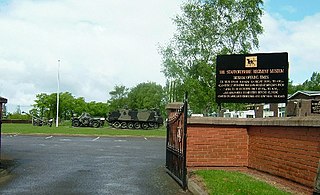
DMS Whittington, otherwise known as Defence Medical Services Whittington, is a military base in Whittington, Staffordshire, near Lichfield in England. It is home to the Staffordshire Regiment Museum, the Headquarters of the Surgeon General and subordinate medical headquarters, and the location of the Defence Medical Academy.

Northern Command was a Home Command of the British Army from 1793–1889 and 1905–1972.

The regimental depot of a regiment is its home base for recruiting and training. It is also where soldiers and officers awaiting discharge or postings are based and where injured soldiers return to full fitness after discharge from hospital before returning to full duty. Normally, a variety of regimental stores will also be kept at the depot. The regimental depot is not the same as the regimental headquarters, though in practice the two will often be co-located in the same place.
In September 1939, the British Army was in process of expanding their anti-aircraft and mobile assets. Among these new changes was the formation of Anti-Aircraft Command which was formed on 1 April 1939, and the 1st Armoured Division formed in 1937. The list below will include the British Army units, colonial units, and those units which were in the process of formation.
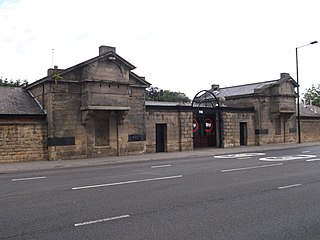
Fenham Barracks is a military installation in Barrack Road, Newcastle upon Tyne, Tyne and Wear, England.

Fulwood Barracks is a military installation at Fulwood in Preston, Lancashire, England. It is set to close in 2030.

Queen Elizabeth Barracks is a British Army installation in Strensall, North Yorkshire, England. It is set to close in 2024.

Wyvern Barracks is a military installation on Topsham Road in Exeter.

Pontefract Barracks is a former military installation in Pontefract, West Yorkshire, England.

The structure of the British Army is being reorganised to the Future Soldier structure. The Army is commanded by the Chief of the General Staff (CGS), with Army Headquarters which is located in Andover, Hampshire. Subordinate to that post, there is a Commander Field Army, and a personnel and UK operations command, Home Command.
The following is a hierarchical outline for the structure of the British Army in 1989. The most authoritative source for this type of information available is Ministry of Defence, Master Order of Battle, and United Kingdom Land Forces, HQ UKLF, UKLF ORBAT Review Action Plan, HQ UKLF, 1990.

2 Signal Regiment is a signal regiment of the Royal Corps of Signals within the British Army.


















